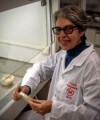Actualidad
White Light Increases Phenolic Compound Content in Apples
Integrated metabolome and transcriptome analyses reveal the mechanism by which white light increases phenolic compound content in apples

Apples (Malus domestica Borkh. Rosaceae Family) are one of the most cultivated fruits globally. According to the Food and Agriculture Organization (FAO), approximately 83 million tons are produced worldwide annually.
Phenolic Compounds in the Nutritional Value of Apples
Apples are highly nutritious and contain minerals, fatty acids, sugars, amino acids, and antioxidants.
In particular, phenolic compounds play a significant role in the biological activity of apples. They have been associated with various health benefits, including reducing the risk of cardiovascular diseases, inhibiting liver toxins, and preventing type 2 diabetes.
Furthermore, phenolic compounds are involved in regulating genes related to lipolysis and fatty acid oxidation. They are key determinants of fruit quality and market value, and their loss during storage is a significant issue.
What are Phenolic Compounds?
Phenolic compounds are secondary metabolites found in vegetables and fruits, responsible for color, antioxidant activity, and resistance to microbial infections in plants.
They are classified such as phenolic acids, flavonoids, stilbenes, tannins, lignans, and coumarins.
The primary synthetic pathway for phenolic compounds is the phenylpropanoid metabolic pathway. In plants, the initial substrate, phenylalanine, is converted into cinnamic acid by the enzyme phenylalanine ammonia-lyase (PAL). Subsequently, a series of enzymatic transformations lead to the formation of flavonoids and phenolic acid.
Light is an essential environmental factor that affects plant development and various physiological processes, including photosynthesis, primary metabolism, and secondary metabolism.
Positive Effects of White Light
A group of scientists studied the effects of exposure to white light (at an intensity of 4 w/m2) on apples and observed that this treatment significantly increases the accumulation of various phenolic substances and total flavonoids in post-harvest apples.
To investigate specific phenolic compounds changing this process, metabolomes of apples exposed to white light for 5 days after harvest were analyzed. Numerous differentially accumulated metabolites were identified, including many phenolic compounds.
Furthermore, RNA sequence analysis identified a large number of differentially expressed genes after exposure to white light, including key enzymes involved in the phenolic synthesis pathway (catalyzing reactions of phenylpropanoid synthesis and derivatives) and the induction of the transcription factor MdbZIP67, resulting in an increase in phenolic content during fruit storage.
Potential to Improve Phenolic Content
These studies propose a new, easy-to-use, and cost-effective method to enhance phenolic content in apples and reveal the mechanism by which white light affects phenolic content during the fruit's shelf life.
Source
Jin, J.; Shen, S.; Zhang, L.; Wang, A.; Yuan, H.; Tan, D. (2024). Integrative metabolome and transcriptome analyses reveal the mechanism by which white light increases apple phenolics. Postharvest Biology and Technology, 208:112640.













